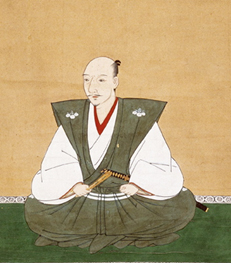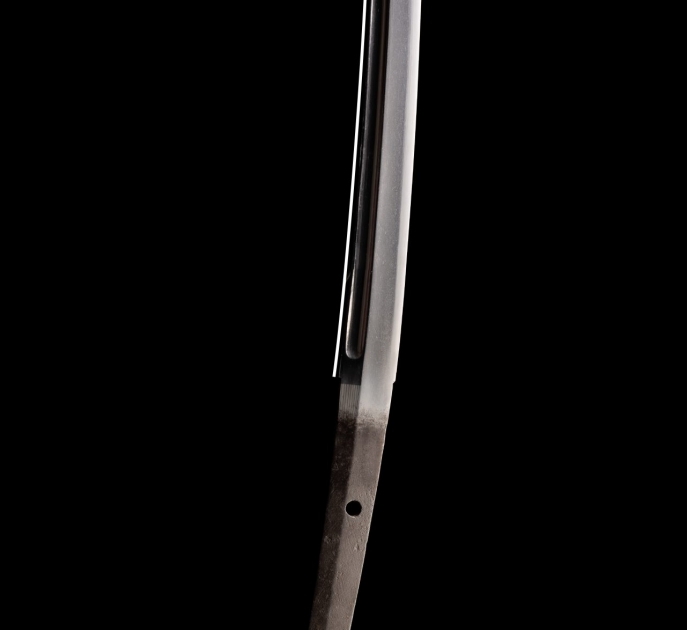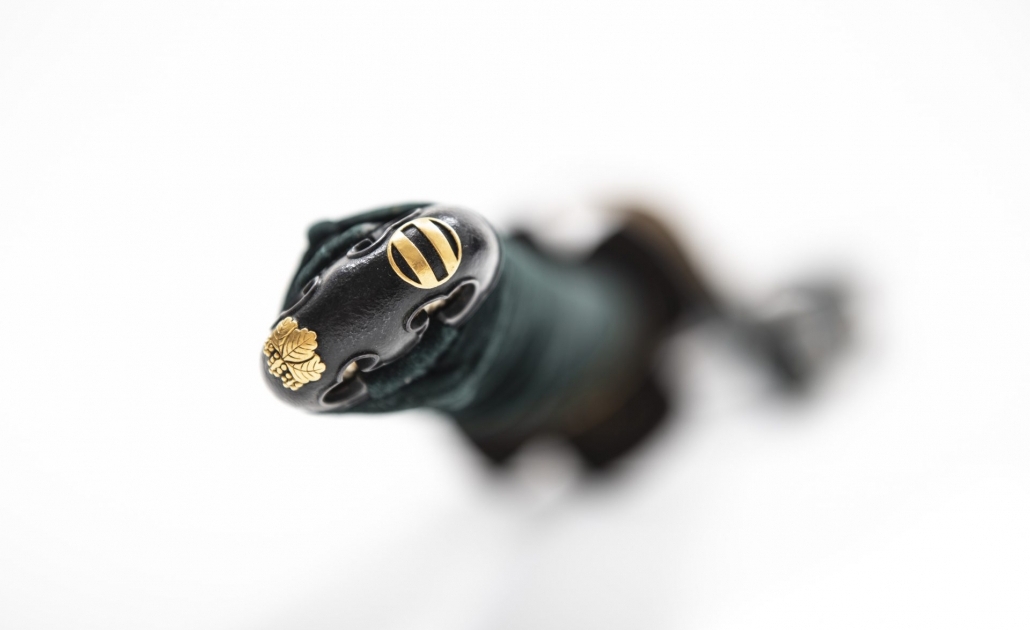Dimensions :
Nagasa : 62.4 cm
Sori : 2.0 cm
Moto-haba : 2.95 cm
Saki-haba : 1.98 cm
Kasane : 0.66 cm
Nakago : Ubu
Certificate – Origami
NBTHK Hozon Tōken
“Worthy of preservation”
Description :
Katana :
Mei : 濃州関住兼房作 – Nōshū Seki-jū Kanefusa saku
Sugata : shinogi-zukuri, saki-sori, iori-mune, chū-kissaki
Kitae : Itame-hada, ji-nie, shirake utsuri
Hamon : Chū-suguha, ko-nie, nioi, fushi, yō
Boshi : Sugu, ko-maru
Horimono/Carvings : Bō-bi
Nakago : Takanoha yasurime, ha-agari kuriji
Koshirae :
Saya : Black lacquer with blue pearl inlay
Tsuba : Iron, jūji-mokkō-gata, shakūdo, tortoise shell pattern, signed 信家- Nobuie
Fushigashira : Shakūdo, gold iroe, clan crests, polish finish
Menuki : Shakudō, yō-bori, gold iroe, Iris motif
Kozuka : Shibuichi, polish finish, tortoise shell pattern, signed 光堂 友常 – Ikkodo Tomotsune
Swordsmith and school :
From the end of the kotō to early shintō period, many sword smith lineages bore the name Kanefusa (兼 房) whose tradition dates back to the Mino-den with the first generation between the Kōshō and the Bunki era (1455-1504). The most famous smiths of this tradition are those who worked in Sue-Seki style during the end of the Muromachi period.
 It said that it was under the last generations between the Eiroku and Genki eras (1558-1572) that the name Kanefusa was the most prolific, especially with smiths such as Iwami no Kami Kanefusa (4th generation). Then, with Wakasa no Kami Ujifusa (5th generation) who settled in Owari province under the authority of the daimyō Imagawa Ujizane. It said that he granted him the privilege of changing his name to “ Ujifusa ”, amending thus the kanji “ Kane-兼” in “Uji-氏”. Later, the quality of his work and his fame earned him the honorific title of “Wakasa no Kami” and the exclusive patronage of the powerful daimyō Oda Nobunaga.
It said that it was under the last generations between the Eiroku and Genki eras (1558-1572) that the name Kanefusa was the most prolific, especially with smiths such as Iwami no Kami Kanefusa (4th generation). Then, with Wakasa no Kami Ujifusa (5th generation) who settled in Owari province under the authority of the daimyō Imagawa Ujizane. It said that he granted him the privilege of changing his name to “ Ujifusa ”, amending thus the kanji “ Kane-兼” in “Uji-氏”. Later, the quality of his work and his fame earned him the honorific title of “Wakasa no Kami” and the exclusive patronage of the powerful daimyō Oda Nobunaga.
The Kanefusa lineage from the end of the Muromachi period, is known for having forged good quality swords with excellent sharpness. This tradition is also famous for its unique temper style called “kenbo-midare”, which is a kind of regular and large chōji-gunome pattern.




































